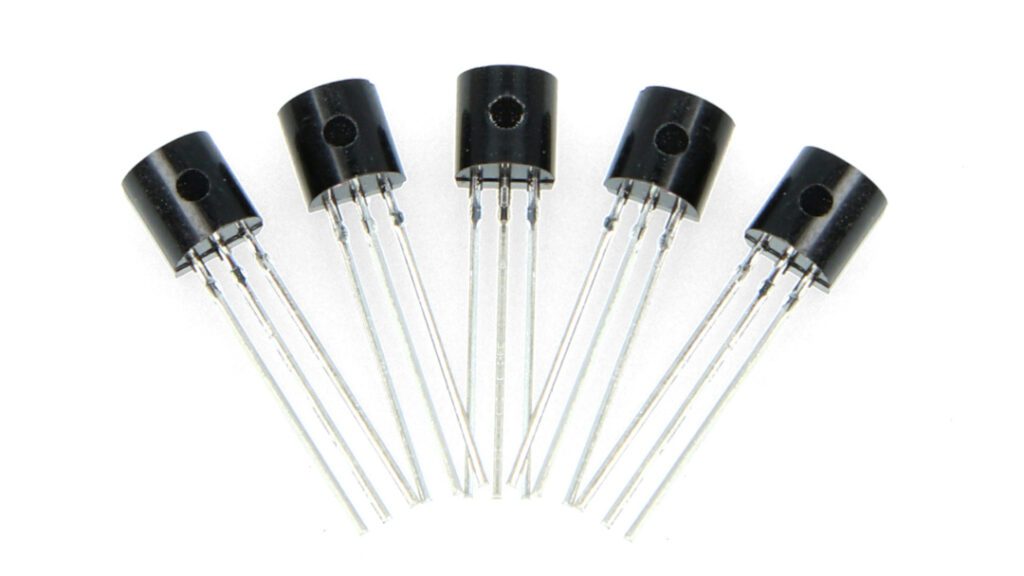Table of Contents:
In this article, we will explore the secrets of a component with the symbol BC337. The BC337 is a general-purpose bipolar transistor that is mainly used to amplify lower-power audio signals, and also as an electronic switch. The BC337 belongs to the NPN transistor family and provides a maximum gain of 630. The continuous collector current is 800mA, which means that the BC337 transistor can control loads with a current consumption of up to 800mA.
BC337 component features
BC337 is an NPN transistor mainly used for lower power amplification and switching purposes. The BC337 contains three leads, i.e. emitter, base and collector. A small base current is used to produce a large current change in the other leads of the transistor. This phenomenon is used for amplification purposes.
BC337 consists of three layers, viz. one p-type doped layer and two n-type doped layers. The p-type doped layer is sandwiched between two n-type doped layers. The base terminal is positive and the other two terminals are negative. Since this is an NPN transistor, the main charge carriers will be electrons. Although both electrons and holes are involved in conduction, in this case the main carriers are electrons, unlike PNP transistors, in which the main carriers are holes. It should be noted that NPN transistors are preferred over PNP transistors because the mobility of electrons is much better and faster than the mobility of holes.
In some cases, electronic designs use a combination of NPN and PNP transistors in the form of a complementary pair.
In an NPN transistor, current flows from the collector to the emitter, unlike a PNP transistor where current flows from the emitter to the collector. However, in both cases, base is the main responsible for controlling the transistor. When a voltage is applied to the base, it becomes polarized, the emitter begins to emit electrons, the flow of which is then controlled by the base current, and in this way electrons are accumulated by the collector. The emitter of the BC337 transistor is heavily doped compared to the other two leads. Through the emitter flows the total current of the transistor, which is the sum of the collector current and the base current.
Basic operating configurations of the BC337 NPN transistor
The BC337 is mainly used in the following three configurations:
- common emitter configuration;
- common collector configuration;
- common base configuration.
The common emitter configuration provides the appropriate voltage and current ratings needed for amplification purposes. This configuration is used for amplification purposes. The gain factor shows the nature of the gain. It is the ratio of collector current to base current and is denoted as ß. Current gain is another important factor, which is the ratio of collector current to emitter current. It is denoted by and is known as alpha. The value of alpha ranges from 0.95 to 0.99, but mostly these values are taken as unity.
BC337 - principle of operation of NPN bipolar transistor
The base of the transistor plays a key role in starting the entire conductivity mechanism of the transistor. When a voltage is applied to the base side, it is polarized and starts the flow of electrons in the transistor. The base current actually acts as a control value that determines the amount of electrons emitted from the emitter region, which are then collected by the collector side. The small base current is used to control the large current at the other two terminals. This process is used for current amplification purposes. The BC337 transistor also acts as a switch. When it acts as a switch, it converts the small current present on one side of the terminal into a much larger current flowing on the other leads of the transistor. The base always has a positive potential with respect to the emitter and collector terminals. In contrast, the voltage on the collector side is always positive with respect to the emitter. An additional resistor is used on the collector side to limit the current flow.
BC337 - maximum permissible operating parameters
The following table shows the maximum permissible ratings of the BC337 component:
| BC337 – maximum permissible values | ||||
| Lp. | Name of parameter | Symbol | Value | Unit |
| 1 | Collector-emitter voltage | Vce | 45 | V |
| 2 | Base-collector voltage | Vcb | 50 | V |
| 3 | Emitter-base voltage | Veb | 5 | V |
| 4 | Collector current | Ic | 800 | mA |
| 5 | Current gain | hfe | 100 to 630 | |
| 6 | Operating frequency | ft | 100 | MHz |
| 7 | Storage temperature | Tstg | -55 to 150 | C |
BC337 component replacements
You may have come across a schematic of a project where custom transistors were used. It turns out that often their parameters are similar to other transistors, including BC337. The following transistors can be used as a replacement for the BC337 with similar parameters. Alternatives to the BC337 include:
- 2SC3912 (SOT-23)
- 2SC3914 (SOT-23)
- BCX19 (SOT-23).
- 2SC3913 (SOT-23)
- BC817 (SOT-23)
- 2SC3915 (SOT-23)
When selecting a transistor for our project, it is prudent to evaluate the pinout, as the pinout of the BC337 transistor may differ from that of replacements.
BC337 - practical applications of the element
The BC337 bipolar NPN transistor has the following example applications:
- Statically switching systems;
- Control of current gain in signal circuits;
- Switching control of actuators, such as relay coils;
- Control of DC electric motors;
- Push-button controllers;
- Robotics;
- Measurement systems;
- Circuits with Darlington/Sziklai transistors;
- Astable and monostable multivibrators
How useful was this post?
Click on a star to rate it!
Average rating 5 / 5. Vote count: 1
No votes so far! Be the first to rate this post.




















